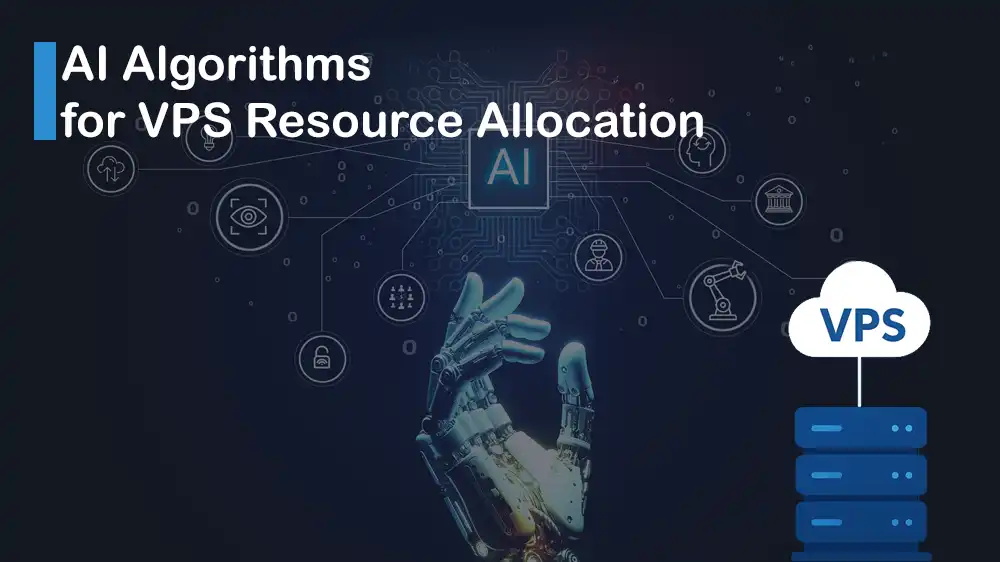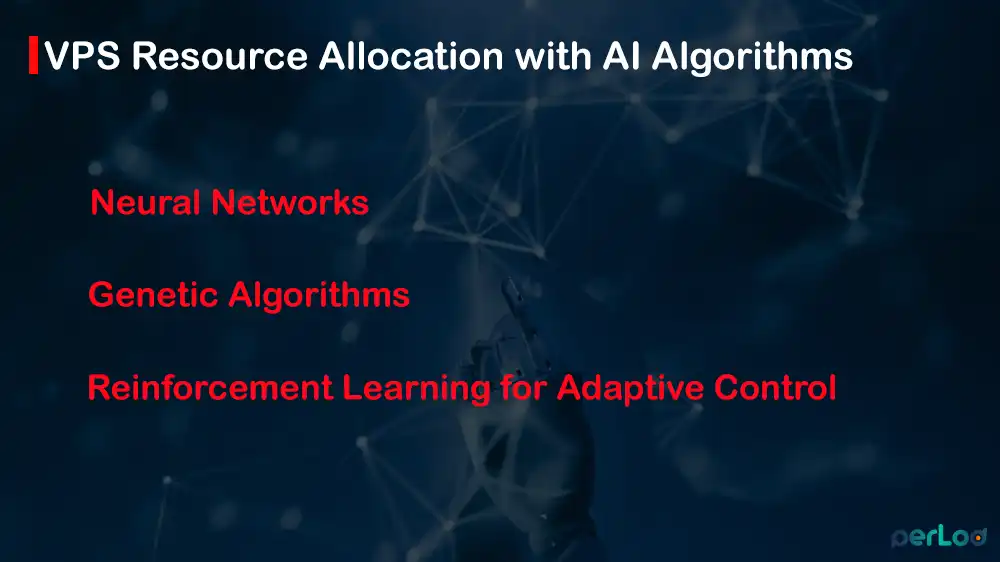
Optimizing VPS Resource Allocation with AI
As you must know, many businesses use Virtual Private Servers (VPS) for hosting websites, apps, and services. As their business grows, managing server performance becomes more complex. Many times, a VPS uses too many or too less resources, which causes inefficiency and unnecessary costs. To solve this, AI is now being used to optimize VPS resource allocation smartly and automatically. In this article, you will explore Optimizing VPS Resource Allocation with AI Algorithms.
AI-powered algorithms can predict, allocate, and balance resources such as CPU, RAM, storage, and bandwidth in real time.
Many hosting platforms, including PerLod Hosting, are leveraging AI-powered systems to deliver faster and more reliable VPS performance. This technology helps balance workloads, reduce downtime, and improve user experience.
Table of Contents
Why VPS Resource Allocation Matters?
VPS performance depends heavily on resource allocation, including how CPU, RAM, and storage are divided among virtual machines. Poor allocation leads to slow performance, server crashes, and wasted energy. For example, if one VPS uses too many resources, others on the same physical server may suffer.
With proper VPS resource management, you will ensure consistent performance for all users, efficient use of server hardware, lower operational costs, and faster response times for apps.
Because of these, you can benefit from AI algorithms that can detect usage patterns and adjust resources dynamically.
Common VPS Resource Challenges
In managing a VPS environment, you will have challenges. Here are the most common challenges in VPS resource allocation:
- Over-Provisioning: Administrators often allocate more resources than needed to avoid slowdowns. This leads to wasted CPU and memory.
- Under-Provisioning: Giving too less resources can cause performance issues, especially during traffic spikes or heavy workloads.
- Manual Monitoring: Manually checking server performance and adjusting configurations takes time and expertise.
- Unpredictable Workloads: Applications like e-commerce stores or streaming services that experience high traffic are hard to predict manually.
- Balancing Cost and Performance: The challenge is to achieve high performance without overspending on unnecessary resources.
To optimize the server’s workload in real time, you can use AI algorithms to automatically balance these factors.
Importance of Smart VPS Resource Allocation
Smart allocation means providing the right resources at the right time based on actual usage data. Instead of guessing, AI systems monitor patterns such as CPU load, memory usage, and I/O operations. Then, they predict when more or fewer resources will be needed.
This intelligent management not only increases performance but also reduces operational expenses and improves energy efficiency.
Understanding AI in VPS Management
AI in VPS management means using intelligent algorithms to analyze, predict, and optimize how server resources are distributed. Unlike traditional systems, AI uses data-driven decisions. AI models can:
- Learn from past performance data.
- Identify bottlenecks before they happen.
- Adjust resources automatically.
- Optimize workload distribution for multiple virtual servers.
How AI Improves VPS Server Efficiency?
AI-driven VPS management focuses on predictive optimization. Here’s how it works:
- Real-Time Monitoring: AI continuously watches system metrics like CPU, RAM, and bandwidth.
- Pattern Recognition: It detects repetitive patterns, such as daily traffic spikes or high memory usage during backups.
- Predictive Scaling: AI forecasts future resource needs and adjusts allocation before performance issues occur.
- Load Balancing: It distributes workloads across servers to prevent overloads.
With this, servers operate more efficiently with faster performance, lower costs, and minimal downtime.
Machine Learning in VPS Resource Prediction
Machine Learning (ML) is a core branch of AI that plays an important role in resource prediction. It uses past data to predict future events accurately.
For VPS systems, ML algorithms analyze historical usage data like CPU, RAM, disk I/O, etc. They learn the patterns and, based on this, the system automatically scales resources up or down.
Optimizing VPS Resource Allocation with AI Algorithms
AI uses different types of algorithms to manage VPS resources efficiently. Each algorithm serves a unique purpose and helps automate different aspects of server management. In this step, we will explore the most common AI algorithms used in VPS resource optimization.

AI Algorithm 1: Neural Networks for VPS Resource Prediction
Neural networks will simulate how the human brain processes information. They learn from large sets of data and can make accurate predictions about future resource usage.
In VPS resource management, neural networks can:
- Analyze traffic data, CPU usage, and memory consumption.
- Identify complex patterns that humans might miss.
- Predict when the system will need more or fewer resources.
Neural networks are excellent at handling non-linear patterns, which makes them ideal for unpredictable workloads like web hosting, gaming servers, or streaming platforms.
The more data the system collects, the smarter it becomes. Over time, it fine-tunes its predictions, ensuring optimal performance without constant human monitoring.
AI Algorithm 2: Genetic Algorithms for VPS Optimization
Genetic algorithms (GAs) are inspired by the process of natural selection. They work by testing different solutions, keeping the best ones, and improving them over time. In VPS optimization, genetic algorithms can:
- Determine the best possible allocation of CPU, RAM, and bandwidth.
- Continuously adjust resource distribution as workloads change.
- Find the most efficient configurations automatically.
The key advantage of genetic algorithms is their adaptive nature; they don’t require exact instructions. Instead, they explore multiple solutions and adapt to new workloads dynamically.
AI Algorithm 3: Reinforcement Learning for Adaptive Control in VPS Optimization
Reinforcement Learning (RL) is one of the most exciting branches of AI for VPS optimization. It works through trial and error. The AI agent tries different actions, learns from feedback, and continuously improves its decisions. In VPS resource management, reinforcement learning can:
- Monitor system states like CPU load and memory usage.
- Make decisions about resource allocation.
- Receive feedback from performance results and adjust strategies.
It enables fully automated VPS systems that respond to real-time changes.
Benefits of Using AI in VPS Resource Allocation
The use of AI in VPS hosting brings several major benefits that directly impact performance, stability, and cost savings. Let’s explore these advantages in detail.
1. Better Performance and Stability:
AI can continuously analyze and optimize VPS performance metrics, ensuring that every server runs at its full potential. Instead of waiting for an issue to occur, AI identifies early signs of resource stress and takes corrective action automatically.
This will keep the VPS environment stable and prevent downtime, even under heavy workloads.
2. Reduced Downtime and Cost Efficiency:
Downtime is one of the biggest concerns for any online business. Every minute of server failure can lead to lost revenue, damaged reputation, and poor user experience. AI significantly reduces downtime by:
- Predicting potential failures before they happen.
- Automatically reallocating resources when one VPS gets overloaded.
- Ensuring consistent uptime through intelligent monitoring.
Also, AI helps cut operational costs by optimizing resource usage.
3. Automated Decision-Making:
One of the biggest advantages of AI in VPS management is automation. AI algorithms can make complex decisions in seconds. The AI algorithms’ decisions include:
- Allocating or freeing up resources based on workload.
- Detecting and fixing performance bottlenecks.
- Managing traffic distribution across multiple servers.
Automation reduces the need for constant manual monitoring, freeing IT teams to focus on strategic improvements instead of routine tasks.
Step-by-Step Implement AI in VPS Resource Allocation
Implementing AI in VPS resource allocation may look complex. But if it is done correctly, it can save time, money, and effort. Here’s a simple, step-by-step guide on how to apply AI to manage your VPS resources effectively.
Step 1: Analyze VPS Usage Patterns
The first step is to understand how your VPS currently performs. Use server monitoring tools to collect metrics about CPU, RAM usage, Disk operations, Network bandwidth, Response times, and Errors.
This information acts as the foundation for your AI system. To monitor your server metrics, you can use built-in monitoring tools provided by your hosting provider or install third-party analytics tools like Prometheus, Grafana, or Netdata.
By identifying performance bottlenecks and usage trends, you’ll know where AI can make the biggest impact.
This step is like giving the AI a map of your VPS behavior.
Step 2: Choose the Right AI Model for VPS Optimization
The next step is selecting an AI model suited for VPS optimization. As we described in the previous step, there are several types you can use, including Neural Networks, Genetic Algorithms, and Reinforcement Learning for Adaptive Control.
Your choice depends on your VPS environment and available data. Many modern AI platforms like TensorFlow, PyTorch, or Scikit-learn make it easier to develop and train these models.
If you’re using a managed VPS hosting service, you can also leverage pre-built AI management systems integrated into cloud platforms.
Step 3: Train the AI Model with VPS Historical Data
Training is where the AI learns. You feed the model with historical data from your VPS, such as weeks or months of CPU, memory, and traffic logs. The AI studies these logs to learn usage trends and predict future needs accurately. The more data it processes, the smarter and more accurate it becomes.
During this phase, the model is tested and validated to ensure it predicts resource allocation effectively. Any errors or incorrect predictions are corrected through repetitive retraining.
Step 4: Continuous Monitoring After Deploying the AI Model
After deploying the AI model, continuous monitoring is essential. The system should:
- Track real-time performance metrics.
- Compare predictions with actual results.
- Automatically adjust its behavior based on new data.
Over time, the AI adapts to new traffic trends, application updates, and user demands. Monitoring tools like Elastic Stack (ELK) or Datadog can visualize the AI’s performance, which helps fine-tune its behavior for maximum efficiency.
Challenges of Using AI in VPS Resource Management
AI offers incredible benefits, but it also has challenges. Implementing AI models in VPS resource management comes with common challenges that businesses need to consider carefully. The common challenges include:
1. Data Privacy and Security Concerns: If an AI model is not handled correctly, this can create privacy risks or expose systems to potential cyberattacks. It is essential to:
- Encrypt all data, both in transit and at rest.
- Use secure servers for AI data storage.
- Comply with privacy regulations such as GDPR.
2. Complexity of AI Integration: Integrating AI into an existing VPS environment can be challenging. It requires expertise in machine learning, server management, model deployment, and real-time monitoring.
Many businesses solve this by using third-party AI solutions or managed VPS platforms that already include AI optimization features.
3. Cost of Implementation: The initial investment in AI model implementation can be high. You may need additional software and hardware resources.
However, the cloud-based AI management systems now allow even small businesses to enjoy advanced VPS optimization without major upfront expenses.
FAQs
How Does AI Improve VPS Resource Optimization?
AI predicts and manages resource demands, ensuring servers always have the right amount of power without wasting capacity.
Which AI Algorithms are Best for VPS Resource Management?
Neural networks, genetic algorithms, and reinforcement learning models are the most effective for predicting and adapting to VPS resource needs.
What’s the future of AI in VPS Resource Optimization?
The future lies in predictive scaling, self-healing systems, and green AI-based resource management that improves efficiency while reducing costs.
Conclusion
Optimizing VPS resource allocation with AI algorithms is one of the smartest moves any business can make today. AI brings automation, prediction, and accuracy to server management, which ensures high performance at lower costs. With the right AI algorithms from neural networks that predict workloads to reinforcement learning that adapts in real time, you can optimize your VPS resource allocation.
We hope you enjoy this article. Subscribe to X and Facebook channels to get the latest updates and articles.
For further reading:
Deploy a TensorFlow model by TensorFlow Serving
